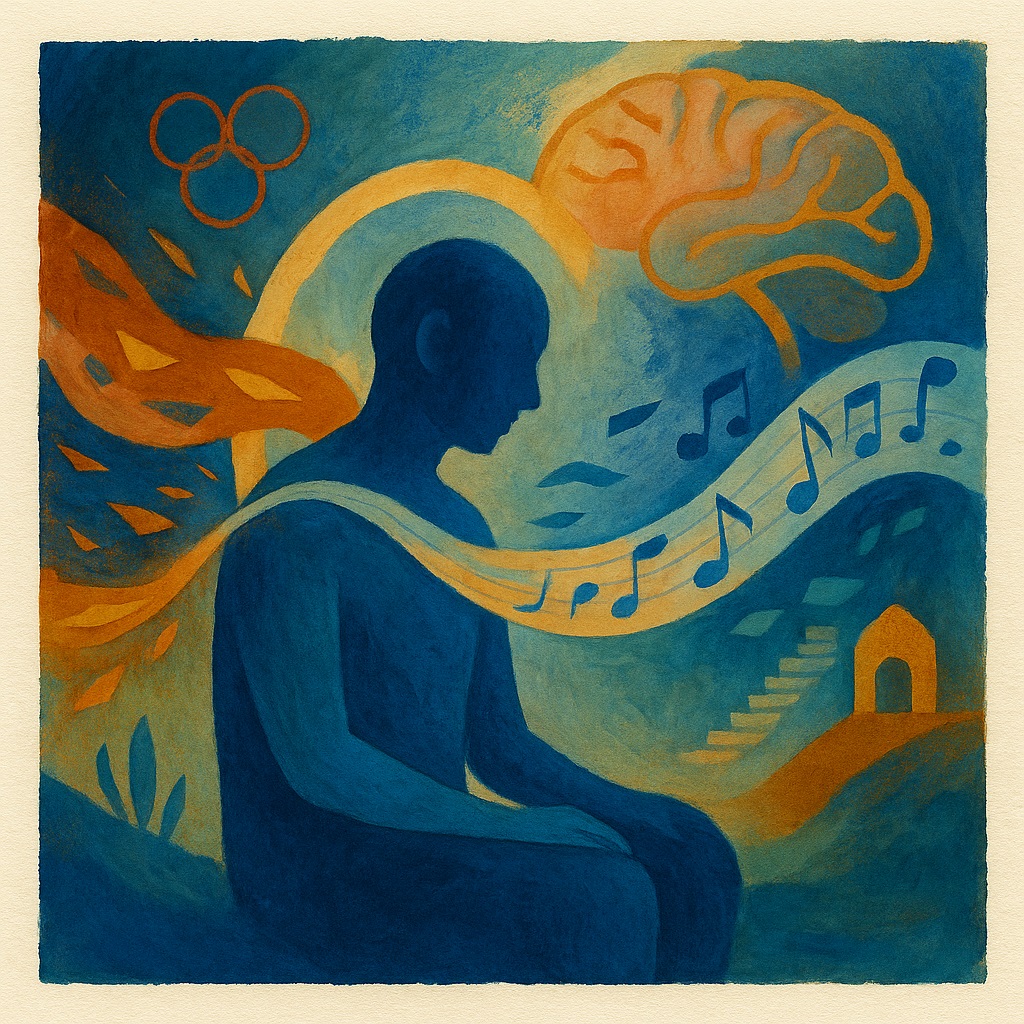Neurotic disorders sit at the intersection of heightened distress, maladaptive habits, and intact reality testing. The group includes generalized anxiety, phobic disorders, obsessive-compulsive disorder, trauma- and stressor-related conditions with preserved reality testing, somatic symptom disorders, and chronic depressive states without psychosis. Music enters this field as a structured time-based stimulus that recruits sensory, motor, affective, cognitive, and social systems at once. This multi-system reach gives music both promise and risk. Promise, because several dysregulated processes in neuroses map onto processes music engages. Risk, because poorly designed interventions trigger arousal, rumination, or avoidance rituals.
This essay focuses on three tasks: first, a clear account of mechanisms with direct relevance for neuroses; second, concrete application templates with parameter ranges and safety rules; third, verification strategies that separate effect from wishful thinking.
1) Mechanisms: where music meets neuroses
1.1 Auditory processing and motor coupling
Auditory cortex, basal ganglia, cerebellum, and premotor areas respond even during passive listening. Rhythm entrains motor timing networks. Pulse regularity stabilizes internal timing and supports predictable breath and movement patterns. Predictable temporal structure reduces uncertainty and supports a sense of orientation. For patients who report inner noise or cognitive traffic, predictable phrasing and steady meter provide scaffolding that competes with intrusive loops.
Key levers
- Meter and pulse regularity: steady, low-variance inter-onset intervals reduce prediction error.
- Event density: fewer concurrent streams lessen cognitive load.
- Dynamic range: gentle contours avoid startle responses.
1.2 Predictive processing, reward, and expectation
Neuroses frequently feature threat-biased predictions and hypersensitive error signals. Music supplies graded prediction error through harmonic tension, cadence, and motif return. When expectations resolve, mesolimbic reward systems respond and shift attention away from threat monitoring. Carefully dosed surprises sustain interest without tipping into vigilance.
Key levers
- Harmonic clarity with limited chromaticism for anxiety-dominant profiles.
- Small, signposted surprises for attentional engagement without hyperarousal.
- Repetition with micro-variation to support learning without boredom.
1.3 Autonomic regulation and endocrine signals
Heart rate variability (HRV) indexes vagal control and stress reactivity. Slow, regular music supports respiratory sinus arrhythmia through breath entrainment. Lower sympathetic drive shows up as reduced skin conductance and steadier pulse. Choral singing and group music show oxytocin shifts and cortisol decreases in several studies. These physiological shifts align with reductions in somatic vigilance and irritability.
Key levers
- Tempo: 56-72 BPM for relaxation, adjusted to individual resting pulse.
- Phrasing matched to ~6 breaths per minute for HRV support.
- Spectral balance that emphasizes warmth over brittle highs.
1.4 Attention, working memory, and rumination control
Rumination rests on sticky attention and recursive self-referential loops. Music that captures attention externally and occupies working memory reduces the resources available for internal loops. Predictable sequences allow attention to settle without constant novelty hunting. When lyrics enter, semantics must support distancing rather than self-referential spirals.
Key levers
- Instrumental material for severe rumination phases.
- Gradual introduction of sparse text only if content supports cognitive reframing.
- Clear motif structure to anchor attention.
1.5 Memory reconsolidation and exposure context
In exposure therapy, context cues influence extinction learning and later recall. Music functions as a portable context marker. Pairing safety learning with a specific musical set during exposure builds a retrieval cue for later use. Music also serves as a controlled source of emotion to titrate activation during imaginal processing.
Key levers
- Use a fixed musical signature during extinction sessions.
- Keep the same loudness, devices, and sequence across sessions to strengthen retrieval.
- Avoid sentimental personal songs for early phases to reduce autobiographical flooding.
1.6 Pain gating and interoceptive accuracy
Somatic symptom disorders often feature high gain on interoceptive channels. Rhythmic attention to a gentle external source reduces the salience of internal noise through competition and gating. Over time, patients train discrimination between harmless interoceptive signals and alarm signals.
Key levers
- Low-frequency anchors that feel steady, not booming.
- Minimal high-frequency jitter that patients interpret as irritant.
1.7 Social synchrony and belonging
Synchronous music making increases prosocial feelings and shared attention. Belonging counters isolation and social threat expectations. Group pulse and call-and-response foster agency without performance pressure.
Key levers
- Simple, inclusive rhythmic patterns.
- Roles that rotate to avoid dominance and passivity.
- Short bouts of synchronized breathing and humming.
2) Application: design rules and clinical templates
2.1 Core design rules
- Safety first
- Stop rule: patient stops the track or session at any hint of panic, flashbacks, dissociation, or compulsive urge strengthening.
- Blocklist: exclude pieces tied to traumatic events or personal crises.
- Expectation setting: music supports therapy; it does not replace formal treatment.
- Parameter transparency
- Document tempo, meter, loudness (in dB(A) at ear), spectral balance, event density, piece length, transitions, and devices used.
- Keep versioning to track adjustments over time.
- Dosing and timing
- Start short and frequent rather than long and rare.
- Align sessions with daily stress peaks or pre-sleep windows.
- Pair with brief breath work and a two-minute quiet phase before and after.
- Agency with boundaries
- Offer choice sets that match the clinical profile.
- Avoid unlimited choice that invites searching and procrastination.
2.2 Receptive listening protocol for anxiety-dominant profiles
Goal
Reduce baseline arousal, stabilize breath, and improve HRV while maintaining alert calm.
Materials
- Headphones or nearfield speakers with flat response.
- Two or three instrumental pieces, each 12-18 minutes, 60-68 BPM, soft dynamics, low event density, stable harmonic field, gentle phrase arches.
Session script (25 minutes)
- Minute 0-2: sit upright, eyes soft or closed, note current tension on a 0-10 scale, 30 seconds of quiet.
- Minute 2-20: play selection at 55-65 dB(A) at ear height. Focus on exhalation lengthening. If thoughts intrude, return attention to the low-frequency anchor.
- Minute 20-23: audio off, remain seated, sense breath and heartbeat.
- Minute 23-25: rate tension again, note changes, one sentence about the most steady moment.
Frequency
5-7 days per week for 3 weeks before parameter changes.
Adjustments
- If restlessness persists, reduce event density and remove high-frequency shimmer.
- If drowsiness appears, raise tempo to 70-72 BPM or add mild rhythmic accents without percussive snaps.
2.3 Receptive listening protocol for rumination-dominant profiles
Goal
Interrupt loops and occupy working memory with structured but non-lyrical material.
Materials
- Minimalist instrumental sequences with gradual variation.
- 65-80 BPM depending on energy level, defined motifs, clear section markers.
Session script (20 minutes)
- Brief pre-focus as above.
- Listen with a simple attentional task: track motif returns and silently count them.
- Conclude with a written note: number of motif returns, one observation about attention stability.
Adjustments
- If counting triggers compulsive checking, drop the count and switch to breath-synchronized attention.
- If emotional blunting appears, reintroduce gentle melodic contour.
2.4 Active music making protocol for low drive and isolation
Goal
Increase positive activation, agency, and social connection.
Format
Small group, 45-60 minutes, weekly or biweekly.
Structure
- 10 minutes: breath and humming in unison, gradual vowel shaping.
- 20 minutes: call-and-response rhythmic patterns with hand percussion or body percussion, meters 4-4 or 6-8, no fast dynamic swings.
- 20 minutes: simple melodic canon or drone-based improvisation on two or three pitches.
- 10 minutes: debrief, each participant names one moment of synchrony.
Rules
- No auditions, no corrections framed as errors, only invitations and mirroring.
- Roles rotate.
- Volume stays moderate to keep physiological safety.
2.5 Hybrid protocol: guided imagery with music for trauma-related stress
Goal
Access and process imagery with controlled arousal.
Materials
- Program of 3-5 instrumental pieces with clear arcs, 15-20 minutes total, neutral cultural references.
Structure
- Preparation: grounding, resourcing imagery, and a shared stop signal.
- Imagery phase: short prompts by the therapist at pre-agreed time points; music volume stays stable.
- Closure: orientation to the room, three senses check (what I see, hear, touch), and a simple cognitive label for the core image.
Guardrails
- No autobiographical songs in early cycles.
- Music remains secondary to pacing and containment.
2.6 Digital adaptive systems
Sensor-guided adjustments use HRV, breath rate, and motion to adjust tempo, dynamics, or spectral content within safe bands. Transparency remains vital. Patients receive a plain-language explanation of rules. Logging stores parameter changes with timestamps to support later analysis.
3) Verification: how to know it works
3.1 Outcomes that matter
Primary clinical outcomes
- Anxiety: GAD-7 or similar.
- Depression: PHQ-9 or similar.
- Obsessions and compulsions: Y-BOCS short or full.
- Sleep quality: standardized instruments plus sleep diaries.
- Somatic distress: brief bodily symptom scales.
Secondary outcomes
- Momentary stress and calm ratings before and after sessions.
- Functioning and quality of life measures.
Physiology
- HRV (RMSSD and high-frequency power) from 5-minute seated recordings before and after sessions twice per week.
- Resting pulse, breath rate, and skin conductance, if available.
- Optional salivary cortisol morning and late afternoon on two weekdays at baseline and week 4.
Behavior
- Adherence: minutes of exposure per week, number of completed sessions.
- Avoidance behavior logs for exposure-linked protocols.
3.2 Study designs suited to real care
- Single-case time-series with multiple baselines and staggered starts across patients.
- Micro-randomized daily interventions that assign one of two music sets each day and collect immediate outcomes through prompts.
- Crossover designs with washout weeks and an active control sound condition matched for loudness and spectral footprint.
- Stepped-wedge rollouts in clinics to compare early and late adopters over time.
- Factorial designs that independently vary tempo, event density, and spectral balance to identify main effects and interactions.
- Bayesian adaptive updates that adjust parameter bands based on response probabilities.
3.3 Reporting standards and reproducibility
Each report lists:
- Stimulus metadata: titles, duration, tempo, meter, key or tonal center if applicable, dissonance indices, spectral centroid targets, dynamic range, transitions.
- Delivery chain: device model, DAC, headphones or speakers, measured loudness at ear level, room notes.
- Dosing schedule, adherence, and dropouts.
- Exact timing of outcome collection relative to sessions.
- Pre-registration of primary endpoints and analysis plans.
- Open storage of anonymized time-series and code where feasible.
4) Parameter reference for practitioners and researchers
- Tempo bands
- Relaxation: 56-72 BPM
- Neutral focus: 68-76 BPM
- Light activation: 74-84 BPM
- Loudness at ear
- Target 55-65 dB(A), avoid peaks beyond 70 dB(A) in anxiety-dominant profiles.
- Event density
- Low: 1-2 salient events per bar
- Moderate: 3-4 events per bar
- High: more than 4 events per bar (avoid in early anxiety work)
- Spectral balance
- Warmth anchor around 100-300 Hz with controlled sub-bass
- Midrange clarity without nasal emphasis
- Treble gentle, roll off harshness beyond 6-8 kHz if sensitivity exists
- Form
- Periodic phrases of 4-8 bars with predictable cadences
- Smooth crossfades rather than hard cuts
- Minimal silence gaps to prevent startle
- Session length
- Receptive: 15-30 minutes
- Active: 45-60 minutes
- Frequency
- 4-7 sessions per week for receptive protocols for the first three weeks
- Weekly or biweekly for group work
5) Risk management and ethics
- Informed consent for any physiological monitoring, with clear storage and deletion schedules.
- Cultural and personal meaning checks before introducing songs with lyrics.
- Immediate access to grounding and orientation techniques during sessions.
- Strict rule against using music as a replacement for exposure or cognitive work when those represent the indicated treatments.
- Fair access: low-cost hardware paths and offline options for those without stable internet or devices.
6) Integration with psychotherapy and medicine
Music slots into treatment plans, not above them. Three integration patterns work well:
- Stabilization phase
Receptive sessions before therapy appointments to lower arousal, followed by short therapist-led reflection tying bodily calm to therapy goals. - Exposure and cognitive restructuring phase
A fixed, neutral music set acts as a contextual tag during exposure. Later, the same set at home promotes retrieval of safety learning. Reflection logs record whether music supports approach rather than avoidance. - Consolidation and relapse prevention
A minimal personal repertoire with two tracks for calming, one for focus, and one for activation. Patients practice transition skills: from over-activation to steady calm, from apathy to light engagement.
7) Case sketches
- Anxiety with somatic focus
A 32-year-old reports chest tightness and catastrophic interpretations. A three-week receptive protocol at 60-66 BPM, 20 minutes nightly, reduces pre-sleep arousal. HRV RMSSD increases from 22 ms to 34 ms across the period, GAD-7 drops by 5 points. Therapist weaves breath-matched phrases into interoception work. - OCD with checking urges
A 28-year-old experiences ritual escalation with counting triggers. Initial minimal music with motif counting worsens checking. The protocol switches to breath-synchronized drones with no explicit counts. Compulsive pressure declines during sessions, Y-BOCS reduces by 4 points in four weeks. The music set remains constant to avoid new rituals around selection. - Trauma-related stress with intrusive imagery
A 45-year-old practices guided imagery with a fixed 18-minute instrumental sequence. The team trains a stop signal, then pairs titrated imaginal exposure with the sequence. Flashback intensity ratings drop from 8 to 5 over five sessions; the patient uses the same sequence for at-home grounding with clear stop rules.
8) What to measure for quality in routine care
- Adherence patterns across weeks and reasons for skipped sessions.
- Immediate pre-post shifts in calm, tension, or urge to avoid.
- Signal quality checks for HRV to avoid artifact-driven conclusions.
- Interaction effects between parameters and individual features such as noise sensitivity, musical background, or trauma history.
- Longitudinal stability at 1, 3, and 6 months.
9) Practical toolkit
- Intake checklist
- Noise sensitivity, trauma-linked songs, device availability, hearing profile, sleep pattern, and daily stress windows.
- Starter libraries
- Neutral instrumental tracks with documented parameters in three bands: relaxation, neutral focus, light activation.
- Session cards
- One-page scripts for receptive, active, and hybrid formats.
- Log templates
- 4-point scales for calm, tension, rumination, and urge to avoid, plus free text for notable moments.
- Adjustment rules
- If arousal rises, reduce event density and treble content.
- If lethargy dominates, increase tempo by 4-6 BPM and add faint rhythmic accents.
- If rumination breaks only briefly, shorten sessions and increase frequency.
References (Open Access where possible)
- Gustavson, D. E., et al. (2021). Mental health and music engagement: review, framework, and guidelines for future studies. Translational Psychiatry, 11, Article 370.
🔗 https://www.nature.com/articles/s41398-021-01483-8
→ Comprehensive review summarizing how musical engagement relates to depression, anxiety, and broader psychopathology. Discusses neurobiological and autonomic mechanisms and offers methodological guidance for future research. - de Witte, M., et al. (2025). Music therapy for the treatment of anxiety: a systematic review. Frontiers in Psychology.
🔗 https://www.ncbi.nlm.nih.gov/articles/PMC12179724/
→ Systematic review of randomized controlled trials on music therapy in anxiety treatment. Includes physiological and psychological outcome measures. - Egenti, N. T., et al. (2019). Randomized controlled evaluation of the effect of music therapy on adolescents with social anxiety disorder. Frontiers in Psychology, Open Access.
🔗 https://www.ncbi.nlm.nih.gov/articles/PMC6708916/
→ Controlled study demonstrating how music therapy reduces anxiety levels in adolescents diagnosed with social anxiety disorder. - Krauss, Z. J. (2019). The Effects of Music Therapy on Individuals Suffering from Generalized Anxiety Disorder. Cedarville University Digital Commons.
🔗 https://digitalcommons.cedarville.edu/cgi/viewcontent.cgi?article=1097&context=musicalofferings
→ Applied study focusing on generalized anxiety disorder, highlighting reductions in somatic tension and rumination. - Ueberholz, R., et al. (2025). Effectiveness of music with auditory beat stimulation in self-report and neurophysiological indices of anxiety. BMJ Open, Open Access.
🔗 https://bmjopen.bmj.com/content/15/6/e094784
→ Explores combined effects of music and auditory beat stimulation. Useful for discussing neural and physiological mechanisms of anxiety modulation. - Yari-Renani, H., et al. (2025). Transforming anxiety, depression, and quality of life in rural populations through music-based interventions. Journal of Affective Disorders, ScienceDirect.
🔗 https://www.sciencedirect.com/science/article/pii/S0165032725008766
→ Field-based research on how music interventions improve anxiety and depression scores in rural communities. - Saskovets, M., et al. (2025). Effects of sound interventions on the mental stress response: a scoping review. JMIR Mental Health, Open Access.
🔗 https://mental.jmir.org/2025/1/e69120
→ Scoping review analyzing the impact of auditory interventions (including music) on stress and anxiety physiology. - Kim, So YaJa & Han, Keum Sun (1996). The Effect of Music Therapy on Anxiety in Neurotic Patients. Journal of Korean Academy of Nursing, 26(4): 889–902.
🔗 https://www.jkan.or.kr/journal/view.php?number=529
→ Early clinical trial on neurotic patients (anxiety, somatization, and neurotic depression). Historically important as one of the first studies to apply music therapy in neurosis-related contexts. - Leslie, G., Ghandeharioun, A., Zhou, D. Y., Picard, R. W. (2019). Engineering Music to Slow Breathing and Invite Relaxed Physiology. arXiv preprint.
🔗 https://arxiv.org/abs/1907.08844
→ Experimental study developing algorithmically composed music to slow respiration and induce relaxation. Relevant for mechanistic discussion of physiological entrainment. - Le, J. (2025). Music Therapy in Depression: Exploring Mechanisms and Applications. Frontiers in Psychology / PMC, Open Access.
🔗 https://www.ncbi.nlm.nih.gov/articles/PMC12026120/
→ Although focused on depression, this paper outlines mechanisms (e.g., neuroplasticity, emotional regulation) directly applicable to anxiety and neurotic symptomatology.
Conclusion
Neuroses involve dysregulated prediction, arousal, attention, habits, and social connection. Music interfaces with each of these through time structure, sensory-motor coupling, graded prediction error, autonomic tuning, and synchrony. Effective practice rests on a few pillars: explicit parameter choices, steady dosing, safety rules, alignment with psychotherapy, and honest verification. With those in place, music serves as a disciplined instrument for stabilization, graded exposure support, and daily self-regulation, while records of parameters and outcomes build a cumulative evidence base rather than another stack of anecdotes.
Supplementary Studies you are probably interested in …
- Music therapy as an adjunct to standard treatment for obsessive‑compulsive disorder and co‑morbid anxiety and depression: A randomized clinical trial (Shiranibidabadi & Mehryar, 2015) — RCT with 30 OCD patients: standard treatment vs standard + 12 sessions individual music therapy. Result: greater reductions in obsession scores, anxiety and depression in the music therapy group. PubMed+2PubMed+2
Link: The abstract on PubMed: https://pubmed.ncbi.nlm.nih.gov/26066780/
(Note: full OA text may not be freely available.) - A Systematic Review of Scientific Studies and Case Reports on Music and Obsessive‑Compulsive Disorder (2021) — Review of 27 articles (n≈650) about music/music-therapy in OCD or obsessive-compulsive personality traits. Findings: people with OCD may benefit from music therapy; also a tendency for increased sensitivity to tense music, increased desire for harmony among OCD/P traits. PMC+2MDPI+2
Link (OA): https://www.mdpi.com/1660-4601/18/22/11799 MDPI+1 - Application of Music Psychotherapy to Social Phobia: Evaluation Study Based on a Mixed‐Methods Design — Mixed-methods study (2014) on individuals with social phobia / neurotic structure: music therapy (improvisation/clinical) over ≈3 months led to improved self-representation, competence and coping in persons with neurotic structure. ResearchGate
Link: https://www.academia.edu/22502275/Application_of_Music_Psychotherapy_to_Social_Phobia_Evaluation_Study_Based_on_a_Mixed_Methods_Design - Personality characteristics, music‑listening, and well‑being: a systematic and scoping review — Examines how personality traits (including neuroticism) relate to music listening behaviour and well-being: Neuroticism was a significant predictor of anxiety reduction through music listening. ResearchGate
(Link may require sign-in.) - Personality traits in musicians with different types of music listening and playing behaviour — Study on musicians: neuroticism associated with higher emotional reactivity to music, implications for emotional regulation. PMC
Link (OA): https://www.ncbi.nlm.nih.gov/articles/PMC11362056/





